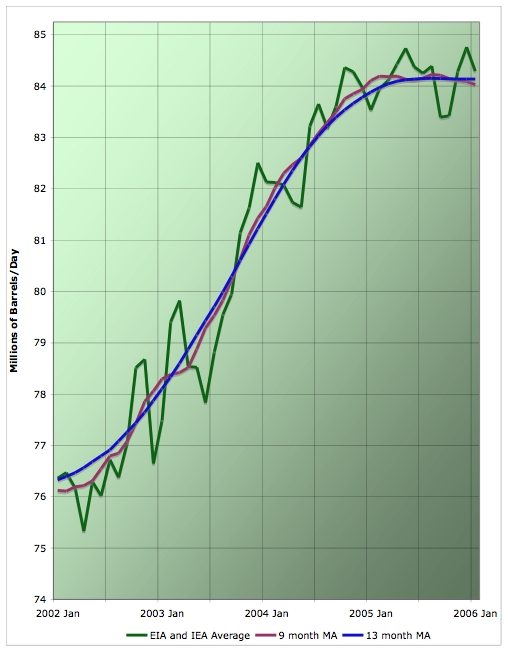
2002 (+) 1.8 M bbl/dy Price $20/bbl-> $31/bbl
2003 (+) 3.4 M bbl/dy Price $31/bbl-> $31/bbl
2004 (+) 2.4 M bbl/dy Price $31/bbl-> $42/bbl
2005 (+) 0.3 M bbl/dy Price $42/bbl-> $62/bbl
2006 ~ 0 (a)M bbl/dy Price $62/bbl-> $71/bbl
(a) all indications are that supply in 06 has fallen.
So, in the face of increasing price, we have a steady increase in production, just as one would expect (even in 2002/03 with the overlay of the Iraq buildup/invasion ~ sabre rattling).
Then, suddenly, in 2005, production flatlines.
Price drop? No.
Recession reducing demand? No.
OPEC, a cartel that could not even keep it's act together during the relatively low prices of the 90's oil glut, finally are working in unison, and contrary to past (seemingly annual now) statements that the current price of oil is too high? I wasn't born yesterday.
Oh, but no. The high prices can't be that of which we shall not speak.
It just has to be Big Oil collusion Bushco sabre rattling Ahjad sabre rattling lack of investment OPEC collusion Chindia demand . . . and on and on and on. . .
Yet, nearly every article mentions 'supply problems', in passing, always secondary to the talking point of the day.
There is a lot of money to be made in the initial stages of that of which we shall not speak, some of which will not be made if the 'consumers' catch wind of the unmentionable, and begin to make other economic and political arrangements.Sarcasm Off: I fully agree with everything you posted. EROEI/Thermodynamics (re: tar sands, oil shale, deep water, <insert non-conventional source here> ) looks like it is going to cause the effects of that of which we shall not speak to hit harder and faster than most of us who have followed this issue imagined. Matt Simmons, in an interview I heard recently, noted that ~0.9 M bbl/dy of US domestic production is from stripper wells where the petroleum energy extracted is less than the electrical energy used in pumping.
On the refinery issue I feel we have been somewhat played. Then again, the private sector is not in the business maintaining excess capacity, or building capacity for feedstock that may not exist.